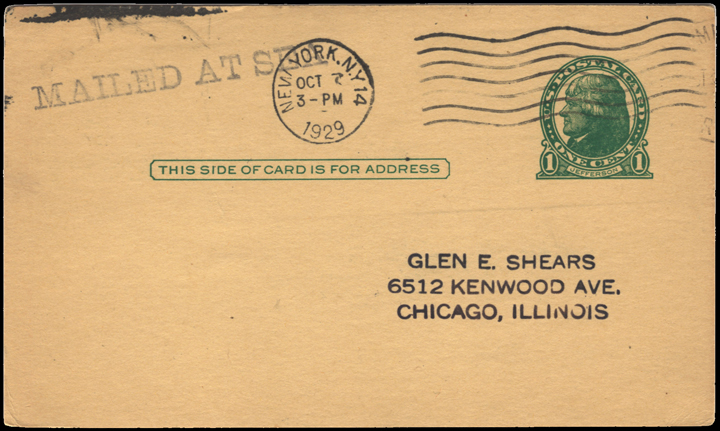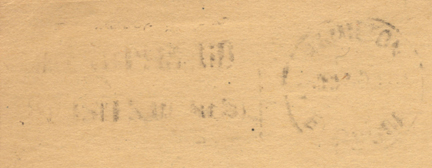|
R.M.S. Lady Somers

This Canadian National Steamships promotional post card depicting a painting of a "Lady Boat" was painted by Scottish
born Canadian artist William Rigg in 1935. The painting is used on post cards depicting each of the five sister ships.

A generic description of the "Lady Boats" appears on the reverse of the post card.



At first glance one wonders why a post card with a Lady Somers handstamp would have a
New York cancellation because New York was not on its itinerary in 1929. The answer is on
the reverse where there is a faint offset Hamilton, Bermuda "COME TO BERMUDA/THE
ISLES OF REST" cancellation next to the "RMS LADY SOMERS/164459/MONTREAL/N/T. 4940"
handstamp. The one cent printed matter rate post card, entered the mail stream in Hamilton and travelled
to the U.S. on another ship, such as the RMS Arcadian, on the Hamilton, Bermuda to New York route.

Kingston, Jamaica Paquebot Cover (Hoskins Type 2402 used from 1920 to 1963) with handstamp from
the R.M.S. Lady Somers franked with 2 cent King George V definitive of June 1, 1935

Boston, Mass. Paquebot Cover with handstamp from the R.M.S. Lady Somers
franked with 2 cent King George VI "mufti" definitive from Canada

Sovenir postcard of "The Rowley's" Bermuda mailed at sea on the R.M.S. Lady Somers
(front of postcard).
One of five sister steam turbine ocean liners known as "Lady Boats" built by Cammell Laird of Birkenhead, England in 1928 and 1929 for the Canadian National Steamship Company, the Lady Somers was a Royal Mail Ship carrying mail, freight and passenger traffic between Halifax, Nova Scotia (and Montreal during the summer) on the western-route to Bermuda, the Bahamas and Jamaica, making a connection to British Honduras. An oil-burner, she had a set of four Cammell Laird steam turbines driving the propeller shafts to her twin screws by single-reduction gearing. She had three passenger decks plus cargo holds to facilitate Canadian exports including lumber, and imports to Canada including fruit, sugar and molasses. The Lady-liners also had additional refrigerated holds for perishable cargo such as fruit, and capacity for 100,000 bunches of bananas. Their hulls were painted white, a colour then confined largely to passenger ships serving tropical or sub-tropical destinations. Lady Somers
with 175 crew and passengers was torpedoed and sunk by the Italian submarine Morosini in the North Atlantic on July 15th, 1941, while serving as an auxiliary cruiser.
Namesakes
The admirals associated with the Lady Boats are not known exclusively for their military or navigational achievements. Although also a successful privateer, Admiral Sir George Somers was carrying colonists to new plantations in Virginia in 1609 when his ship, the Sea Venture, was wrecked on a reef off Bermuda. Most of the castaways survived and made their way to Virginia but Somers was sent back to Bermuda to gather supplies. He died there in 1610. His heart was buried there and the islands were named the Somers Islands. The admiral and his ship, the Sea Venture, are portrayed on Bermuda’s 2 1/2d Queen Elizabeth II definitive of 1953.

Admiral Sir George Somers and his ship, the Sea Venture, are
portrayed on Bermuda’s 2 1/2d Queen Elizabeth II definitive of 1953.
|
Sources
Boileau, John . "The Lady Boats." Legion. 1 Jan. 2007. Web.
21 May 2023.legionmagazine.com/en/the-lady-boats/.
Hanington, Felicity and Capt Percy A. Kelly. The Lady Boats: the life and times of Canada's West Indies
merchant fleet. Halifax, N.S.: Canadian Marine Transportation Centre Dalhousie University, 1980.
Vleggeert, Nico. "SS Lady Somers." Wreck Site. 12 Mar. 2008. Web.
30 May 2023.wrecksite.eu/wreck.aspx?31096.
|
Go to the Grose Educational Media Home Page.
© Derrick Grose, 2023-2025
|











